Fieldwork (le terrain) is not a simple act of “discovering” but rather a much more complex process, one that manifests itself over time and involves the researchers themselves.
Valérie Gelézeau & Benjamin Joinau
Note: The co-edited book on “doing fieldwork in North Korea” by Valérie Gelézeau and Benjamin Joinau was not yet published to be included in paideia issue 2 (Fall 2021), but given the stir it has caused as an “Unidentified Literary Object” and the methodological experimentation embodied in both its form and content, this additional contribution seems especially apt, and timely too, in Fall 2022. —Suzy Kim, editor
“Doing fieldwork in North Korea” as a “Western” academic is highly suspicious! Over “there,” as Katherine Verdery realized years after her PhD research, you might be watched as a potential spy, or a journalist, or a proselyte – maybe only in your imagination.1 And over “here,” in the “West,” you will definitely encounter a few raised eye-brows expressing all doubts about your capacity to do fieldwork in that country.
In our co-edited book Faire du terrain en Corée du Nord: Ecrire autrement les sciences sociales (Paris: Atelier des Cahiers, 2021), we refused to forfeit to this somewhat depressing statement and, instead, chose to share all that we can about our experience of doing fieldwork in North Korea, or at least going there, with a research purpose. After all, we do have projects, intentions, methods, and questions, as demonstrated in the City-NKor project that funded our last travels to North Korea (2016 and 2018) and sustained the publication of the book. This project is now funded by the French National Research Agency, gathering a multidisciplinary team of fourteen scholars, including five doctoral students and post-docs. It engages with the city and its construction (architecture and urbanism), which was – and still is – one of the matrix of the modernization and construction of the North Korean socialist state, while distancing itself from the orientalizing and the moralizing perspective that often underlies research on North Korea.2
To some extent, the book, which originated in one of the pioneering fieldtrips made in 2013 by a team of EHESS’ Centre for Korean Studies, can be considered as the origin of the City-NKor project. The work of imagining, writing, and co-editing this book took a long route (2014-2021), first developed on the 2013 trip as well as several other voyages that different members of the project have made since the early 2010s (Dr. Chabanol having been to North Korea over 30 times).
Valérie & Benjamin’s Videobio
So, do we really think we do fieldwork in North Korea as the title of the book suggests?
For more than twenty years, anthropologists and ethnologists have adopted critical approaches to their disciplines and have demonstrated that doing fieldwork (faire du terrain) is never objective or transparent, that the facts collected “there,” even the most apparently neutral ones, are always reconstructions and interpretations; and that what one may take from these facts is perhaps especially to be found in the interstitial spaces and/or detours of these interpretations.3 Fieldwork (le terrain) is not a simple act of “discovering” but rather a much more complex process, one that manifests itself over time and involves the researchers themselves.
And yet – as testifies the raised eye-brows – the issue of “fieldwork” in North Korea remains stuck in a kind of pre-historic scientific limbo: as if there were a “reality” to see or discover in North Korea rather than a society in need of description and (critical) analysis. As if we were explorers faced with “virgin” space to be conquered rather than researchers confronted with social facts (space being one of them) to be interpreted. In short, one of the particularities of North Korea research is to reduce us to a form of positivism mostly associated with the origins of social sciences.
But then, indeed, going to North Korea and trying to do research, gather materials, and practice scientific engagement as we try to do, is a challenge. And we doubted for a long time that we would ever have something to publish about “doing fieldwork in North Korea.”
So what is in the book? What can we, academics, say and share about fieldwork in North Korea? Our book was recently qualified as an ULO, an Unidentified Literary Object, in a review by Antoine Baronnet on a blog of French history and geography teachers. It is indeed a hybrid and strange object and we will do our best, here, to present some of its contents, and our perspective in putting it together.
What this book is for Valérie
What this book is for Benjamin
As Valérie suggests in explaining what this book means for her, this work is about sharing our experience of fieldwork in North Korea, no matter how messy, confusing, and bizarre it is, in tune with what geographers Anne-Laure Amilhat-Szary and Myriam Houssay-Holzschuch did during their 2016 collective fieldtrip in South Africa.4 As Philippe Descola well argues, any fieldwork, anywhere, confronted with the asperities of space, situations, and people is messy and confusing – no matter how well-groomed are our research projects on paper when applying for funds for the fieldwork trips, or how coherent and organized our Back-to-the-Office Reports can be.5 In this book, instead of presenting only the well-groomed stuff (a number of chapters serving as the edited reports after the fieldtrip), we decided to expose our messy materials, along with the peculiar temporality of fieldwork, which we conceive as a continuum between here and there.
Fieldwork starts “here,” which is for us somewhere in Europe, mostly in France, before the trip, with a complex series of actions ranging from the exchange of program proposals and site visit requests by email with the North Korean partners who will be hosting us, to official meetings with the DPRK delegation in Paris for the visa process, including a last minute frantic ritualistic ballet of passport collection and distribution.
During the stay in Pyongyang, the fundamental dynamics of fieldwork is the process of negotiating the day to day iljŏng, or schedule. The book details what we planned to do, what we actually did, and what unexpected events (from the sickness of a member of the team to the urge for pizzas or the need to receive a wihyangsŏ, a letter of intention for future trips) influenced our daily program.
Image 1 – About messy documents (iljŏng and its many revisions)

About messy documents – commentary on iljŏng
We continue to “do fieldwork” even after returning from the fieldtrip. There was, for example, a “Return from North Korea” roundtable organized in Paris, and the papers and books we may individually write afterwards. But beyond that, the purpose of our scientific engagement includes also sharing research over the long term with our North Korean colleagues.
So, when we organize their fieldwork in France, we try to meet their demands and needs – as we hope they will do for us the next time. We may visit together a large development zone, including housing programs, to discuss urban principle in greater Paris, or a small ancient public theater to investigate temperature control in cultural and historical buildings. And to understand their questions about how things work here, in Paris, we often need to ask questions about how things work there, in Pyongyang. And that is how, little by little, by the common sharing of interests and research questions with our North Korean colleagues, fieldwork in North Korea can actually take place in France.
Fieldwork is not limited to locations where we think it is.
In North Korea, how can we guarantee the “fieldwork pact” described by geographer Yann Calbérac, who notes the proximity of this pact with the “autobiographical pact” theorized by the literary critic Philippe Lejeune?6 If “the issues at stake in drawing upon fieldwork are to generate belief in the veracity of on-the-ground observations and simultaneously vouch for the arguments that are presented as following from them,” how can one be doing fieldwork in a country where everything is, supposedly, only propaganda and a vast Potemkin village, a country where we can’t allegedly see or do anything?7
Indeed, in North Korea, it seems impossible to undertake proper ethnography: we have no freedom to carry out participant observation or in-depth systematic surveys, and empirical data (like statistics) are scarce and uncertain. Our answers to the specific constraints of such a “closed context” of fieldwork, which were otherwise well described in a special issue of the journal Area edited by geographers Michael Gentile and Natalie Koch, are multiple.8 And they require taking a few detours from what is usually imagined as “serious” research. How did we manage these detours?
We activated our playful inner child and talked to our inner artist.
Inspired by geographer and Japan specialist Henri Desbois, the hunt for “thomassons” was one strategy that we implemented, as a group, to put the visual at a distance and develop another way to look at the city. The thomassons, a 1970s invention by the Japanese neo-Dadaist artist Akasekawa Genpei, are used by some French geographers eager to look differently at cities.9 As Henri explains in the book, thomassons are urban objects that have lost their meaning in the course of the perpetual evolution of the material city, such as a staircase going nowhere or a permanently closed window. Searching for thomassons actually acted as a methodological tool to step outside the very literal visual behavior of foreign observers in Pyongyang or North Korea. But there were also some hidden causes behind this choice. As we explicitly explain in the red thread of our editors’ dialogue, “It was a game at first.” And indeed, the playful idea of a treasure hunt targeted to strange urban objects in Pyongyang was very appealing and did work as an active dynamic for a different, fun look at the city, in the spirit of “nerdy fun research” – as Paul Silvia defines it.10
In fact, one of the keys to doing fieldwork in North Korea is to go there open minded, and only our playful child’s minds could do this.
Distancing the visual was also very important for us, and one way to do this was to consider carefully the collection of our fieldwork pictures and the way we use them in the book. Images are thus treated differently depending on the significance they have in the general architecture of the book. The image of the chapters themselves are rendered in black & white, as iconic quotations of each author’s argument, while the pictures of the team during the fieldtrip are presented colored as they are, like in a family album. Lastly, the pictures of Pyongyang, as a discourse on the city itself already embedded within our analysis about it, were transformed into sketches in colored ballpoint pen by Sun Mu, a well-known North Korean artist now living in Seoul.
Images 2, 3, 4, 5: Our pictures and their translation by Sun Mu
Image 2 & 3: Rollerblades in front of Grand People’s Study House
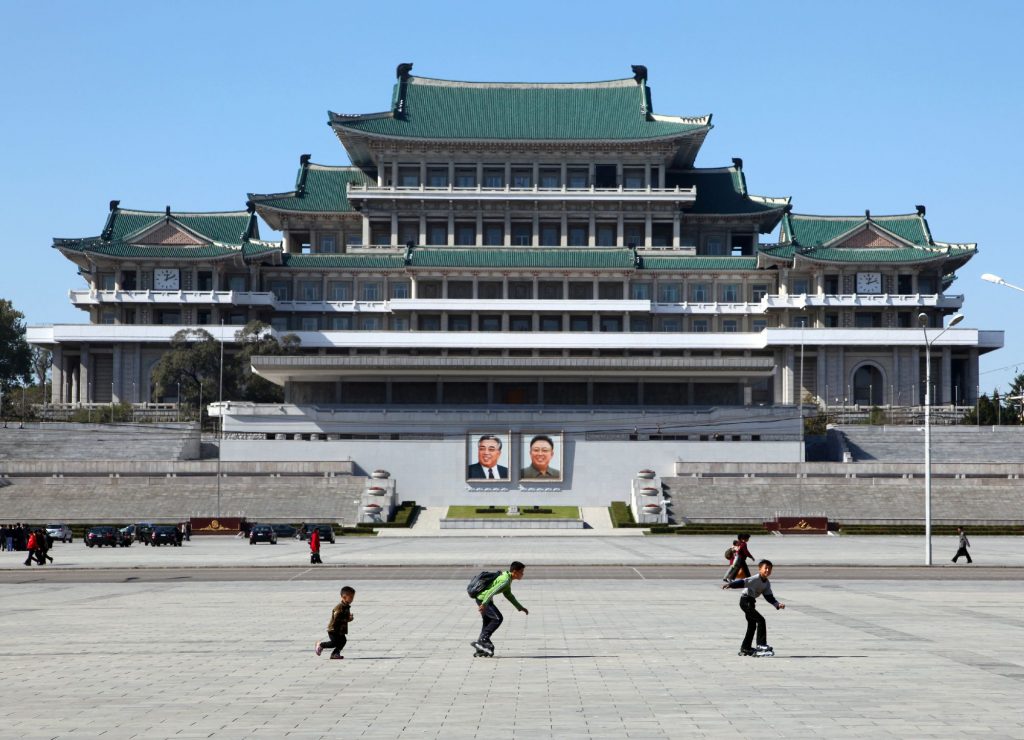
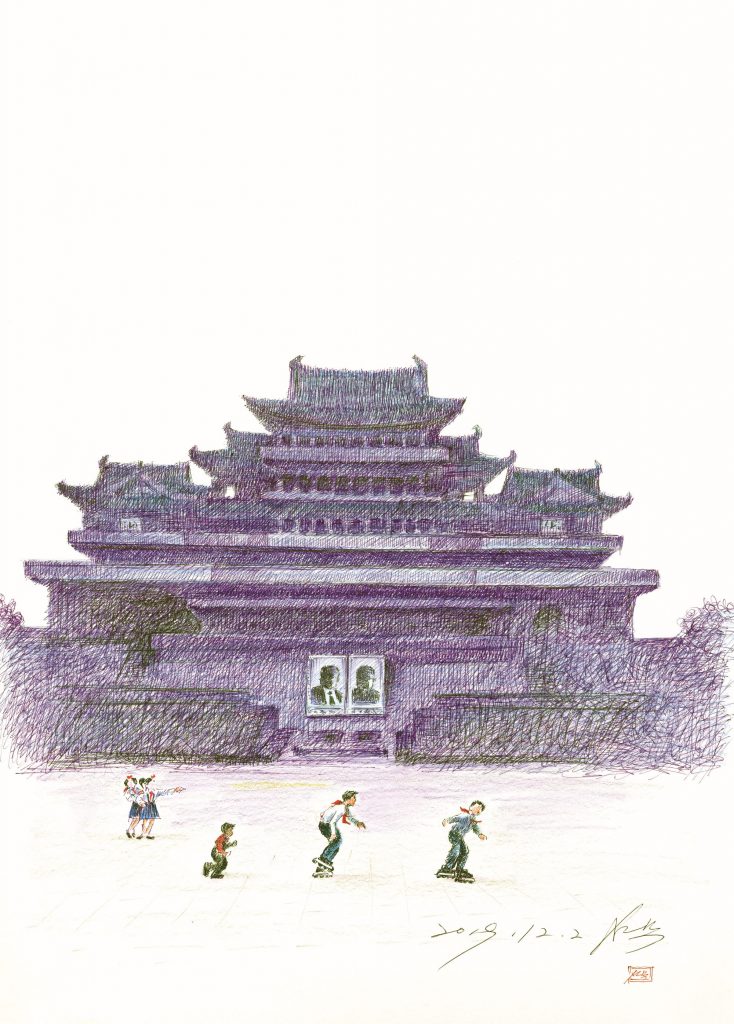
Image 3 & 4: A street in Kaeson-dong
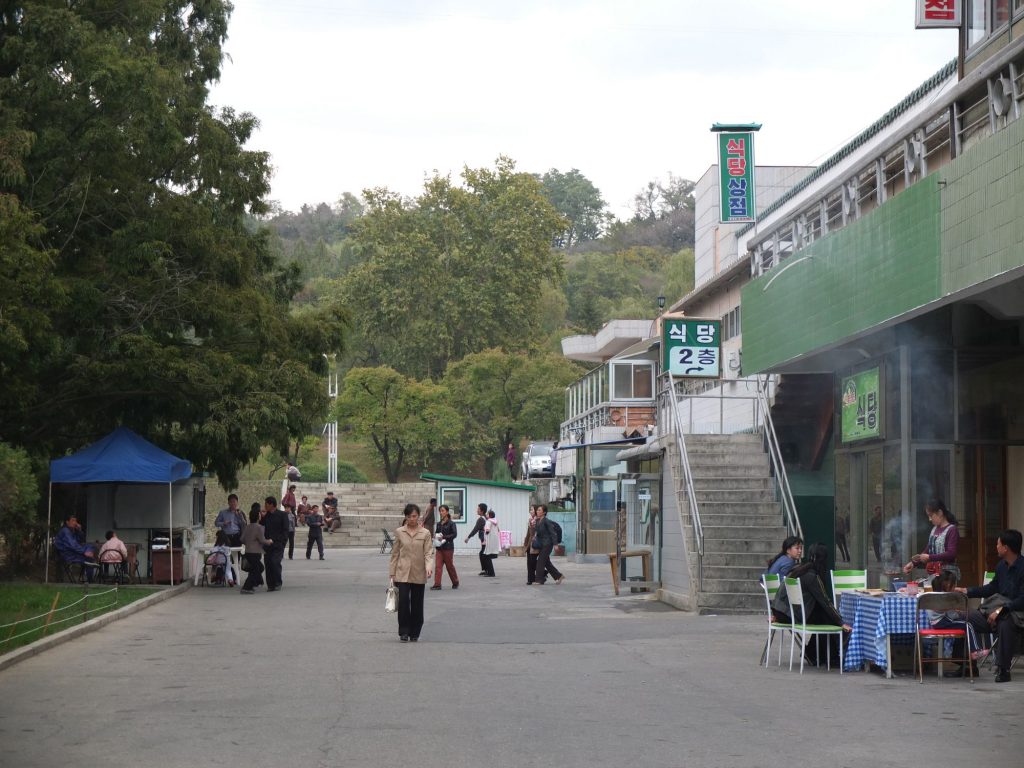
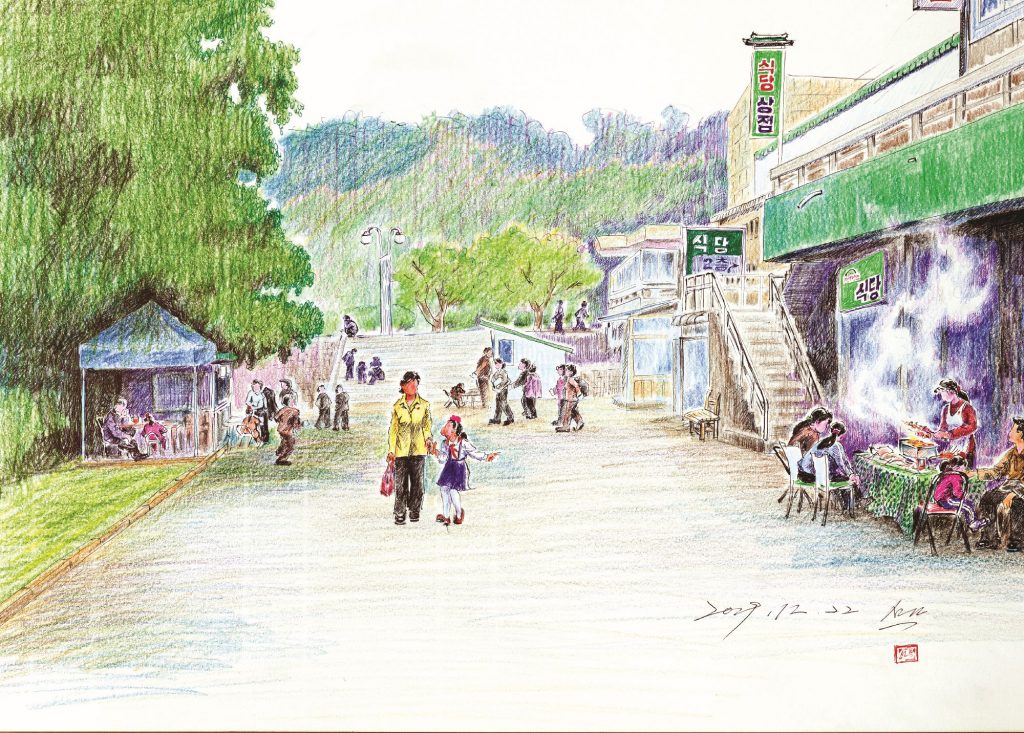
In fact, Sun Mu’s artistic translation of our photographs adds emotion and the sense of living in the place. His drawings thus show, maybe better than any argument, that Pyongyang is, after all, a livable city and a city where real people live.11
Pictures & drawings: reality and the sense of living by Benjamin
And finally, some of us such as Alain Delissen, did meet their inner artist and wrote pieces that look more like poetry than reports – and at the same time, express very well the essence of our wanderings on the field.
Alain’s poetry: reading and subtitles
« I am a fieldnote » – commentary about Alain’s poetry
“I am a fieldnote” is the title of an essay by Jean Jackson.12 An important body of critical literature in anthropology and geography analyzes what fieldwork does to researchers, and how the roles we play on the field are far from simple and univocal.13 Likewise, the people we work with on the field may assume different roles: our North Korean university colleagues are also our guides (annaewŏn), sometimes informants, and, eventually, they may become friends or at least people who are close enough to remember our birthdays, call to wish a happy new year, or inquire about moving homes and children.
In the book, we tried to emphasize yet other roles or behaviors that we, scholars in social sciences, manifest on the field. Scholars are strange animals actually driven by passion and curiosity, which are fundamental drives of research – otherwise, frankly, why would they go to North Korea? Sometimes scholars are obsessed with their “object,” as a couple of chapters show. Why should one collect all the songs of a revolutionary concert of the Moranbong band with the Korean People Army choir? Why should one translate, integrally, the list of the hotel’s laundry items, when you are a male researcher working on Buddhist geomantic monks? Yes, seriously! Why do we do such things?
Because we are curious, passionate, and sometimes obsessed with our research, therefore collecting every material we can on the field, including apparently “useless” lists, such as names for different kinds of clothes. One of our students may need it one day, you never know!
Passionate and obsessed, scholars are emotional beings, which is what we tried to express in the last part of the book explicitly titled “Le terrain ou la valse des émotions” (Fieldwork and the waltz of emotions). Any fieldwork triggers emotions, but those emotions seem more intense in North Korea – maybe because the “closed context” creates the conditions of a restricted experience and thus acts as a fieldwork laboratory. In fact, the North Korean fieldwork laboratory, and the intensity of the situation, allowed us to pinpoint and express problems or emotions that scholars usually hide, such as the default of memory regarding what happened on the field, the shame or anger of feeling instrumentalized, or having to instrumentalize our partners – readers who never experience such feelings or problems on fieldwork should stop reading right now. Can you see how, when we consider things a different way, fieldwork in North Korea, rather than being non-fieldwork, becomes actually a paragon of fieldwork?
In fact, using emotions themselves may help the scholar who wants to better exert their analytical faculties, and develop their emotional intelligence. Having a sense of humor is a great way to do this and, at the same time, helps to shake off the pressure of the closed context during fieldwork.
Image 6 – Humor in the field: our comic view of an evening in Pyongyang
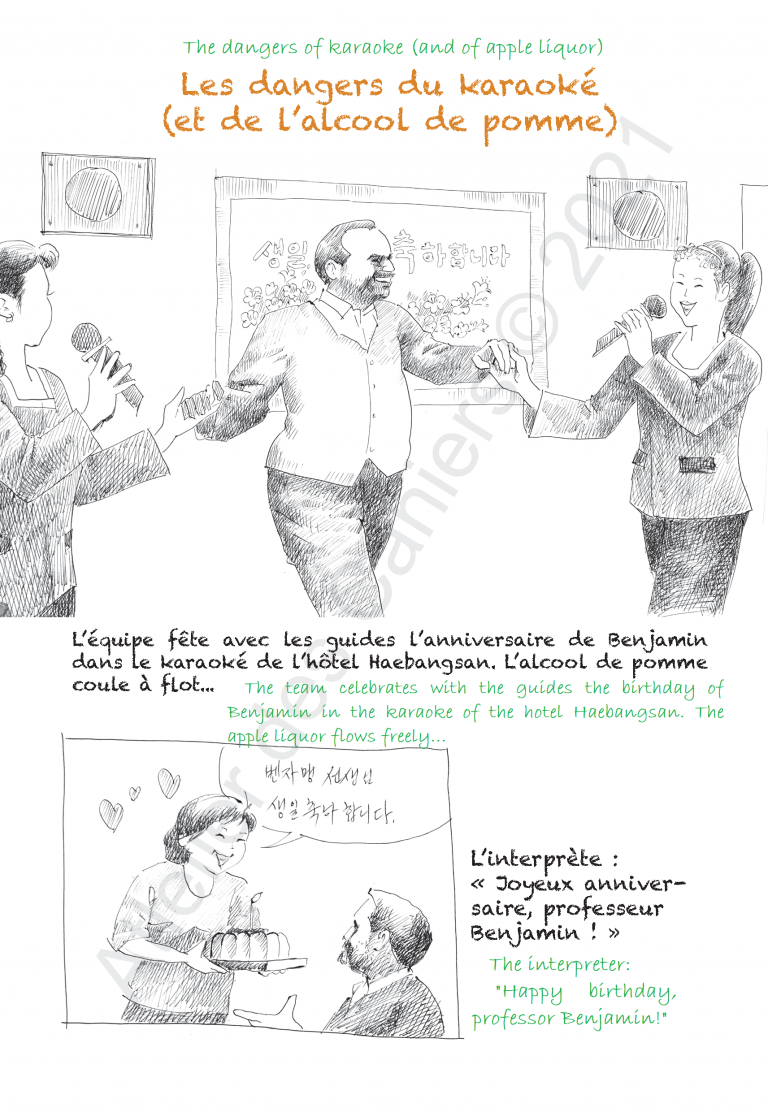
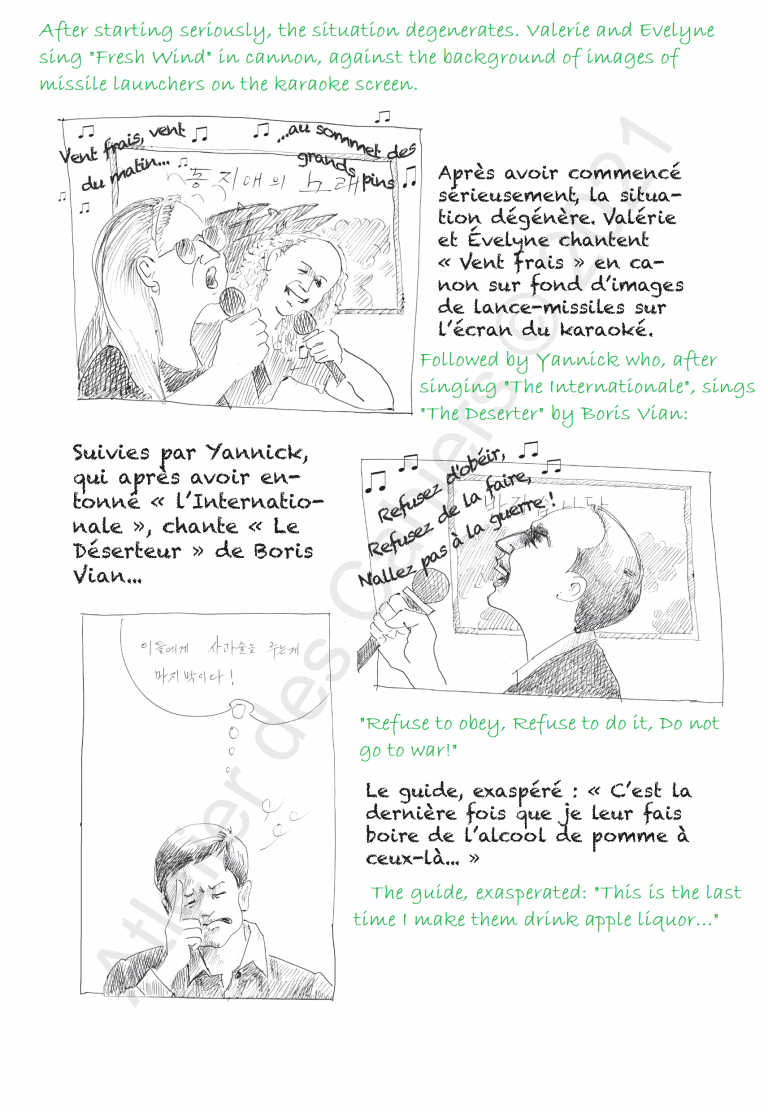
One thing which we had not really planned but emerged in the course of writing the book was to share the co-writing process and expose it materially in the text layout. Coming back from fieldwork with non-conventional materials, experiences, a process in the making and yet a lot to do, made it hard to write a conventional opus. The fragmented form we were aiming at was also a way to signify our will to avoid the essentialization of North Korea, or of “the North Koreans” as monolithic or homogeneous. At the same time, we realized that, most of the time, our academic way of writing and research, especially in edited volumes with several editors and several authors, involved fascinating discussions, such as the choices we constantly had to make about names, transcriptions, images. But usually, all those significant “backstage” processes are hidden in the final manuscript. We thus decided to include the everyday dialogue of the editors in the book margins, like a red thread of its co-creation.
The red thread of the book: editors dialogue in the margins
This was our way to express our everyday dialogues, or conversations, which are usually silenced in published books. And we are glad, in this essay, to use new formats such as audio and video, in order to expose our red thread, and show that writing an edited volume is not only making choices, but also taking risks, and accepting imperfections and failures – the fact that we forget things, that people do not respect our choices and that, sometimes, everything seems to be a real mess despite our efforts to harmonize things.
Harmony, totality and the academic book by Benjamin
****
To some extent, this book is a fieldwork manifesto, not only about fieldwork in Korea, but about fieldwork in general. The book tries to express the fragmented reality that fieldwork is, which blends the scientific mind of the researchers with their emotional being, their inner child or artist, and all their shadows and imperfections – such as being obsessed and forgetful about who took a picture or what exactly happened during a visit or in interactions with local people. The book also follows the continuum between here and there, which locates fieldwork in places that are geographically distant from it (e.g. in Paris). Finally, this book is a manifesto of what collective writing is in academia: an enormous amount of work, an adventure both fun and frustrating, and one of the greatest ways to actually work on ideas in a research community. We tried to share all that in the book by explicitly using a non-conventional format – the QR code below will take you to the book.
We worked hard despite the imperfections and limits of our enterprise, and that means there are many other books to write yet, and this feels like a wonderful prospect to us.
In closing, we shall “meet” you again in the final video capsule.
Conclusion and thanks to all authors
The book QR code –

A geographer and Korean Studies specialist, Valérie Gelézeau is Professor at EHESS (École des hautes études en sciences sociales) in Paris, and the director of the Centre for the Studies of China, Korea, and Japan (UMR8173 CNRS-EHESS-Université Paris Cité).
Benjamin Joinau is a doctor of Cultural Anthropology specializing in Korean Studies. He is an associate researcher of the Centre of Korean Studies (CRC) at EHESS, Paris, and professor at Hongik University, Seoul. He has been living and working in South Korea since 1994.
Contributing authors of the book include Yannick Bruneton (Université Paris Cité, Evelyne Chérel-Riquier (La Rochelle Université), Koen De Ceuster (Leiden University), Alain Delissen (EHESS), Henri Desbois (Université Paris Nanterre), Françoise Ged (Cité de l’architecture & du patrimoine), and Pauline Guinard (Ecole normale supérieure).